ChatGPT:教您9种智能化的SEO关键词研究方法
在SEO领域,用ChatGPT进行关键词研究、生成标题、撰写文章、分析数据等已经不是什么秘密了。但也还有很多人还没能熟练地用起来。
在这篇文章中,我将重点介绍9种使用ChatGPT 进行关键字研究的方法,其中第9种方法是其他SEO关键词工具目前无法做到的。
备注:在未特别说明的情况下,本文所指的SEO是Google SEO,所有示例也主要针对Google SEO。

Contents
9种方法教您如何使用ChatGPT进行关键词研究
1. 发现关键词
ChatGPT 可用于关键字发现,只需向ChatGPT询问相关关键字即可。
您的查询指令可以是:
示例1:Generate X keywords for “Keyword” (中文:请根据“关键词” 生成X个关键词)
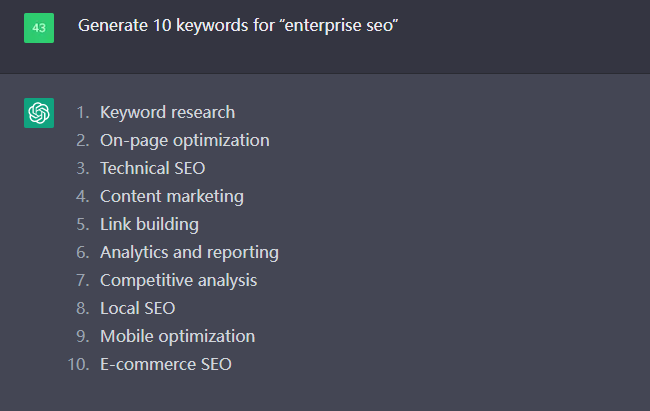
示例2:Make a list with keyword related to “keyword” that one might use to search in Google (中文: 请生成一个与 “关键词”相关的且人们可能会在Google中进行搜索的关键词列表)
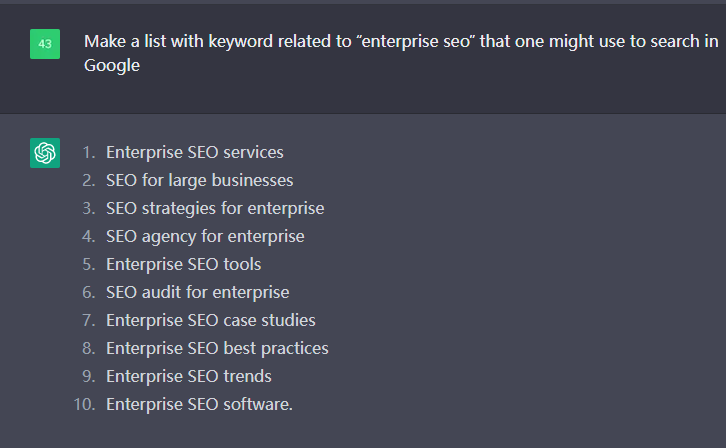
在这个指令下,我们还可以进一步细分人群得到更相关的搜索结果:
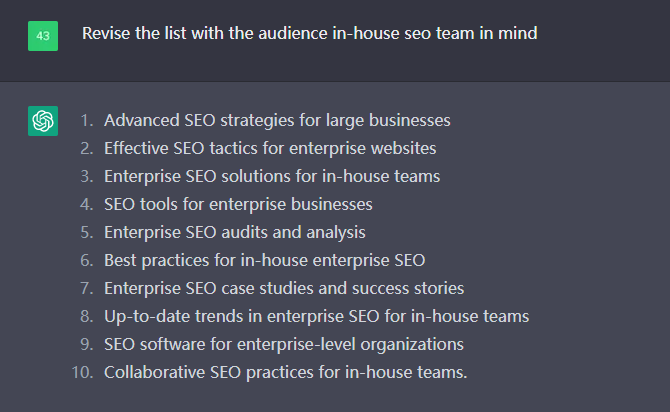
在上述两个指令中,我们会发现第一个指令下的关键词结果比较宽泛,而第二个指令下的关键词结果相关度很高。
在实际工作中,我们有时需要宽泛的关键词建议帮助我们进一步拓展关键词,有时又需要更为相关的结果帮助我们缩小话题范围并找到在大主题下最适合我们的关键词。因此,您可以根据实际需要切换使用上述两个指令。
2. 批量生成同类关键词
在电商SEO或Local SEO中,我们常常会有很多类似的关键词的,例如类似“美国最好的SEO服务商”、“印度最好的SEO服务商”、“德国最好的SEO 服务商”等这种只更换一个词的关键词。ChatGPT可以快速帮您生成此类关键词列表。
示例1:“Keyword”, please swap out “A word in the keywords” in this keyword and replace it with “other XX“. Sort them in order of popularity. Make it a list.
在下面的这个示例中,我让ChatGPT更换关键词中的地点生成一组新的同类型关键词列表。
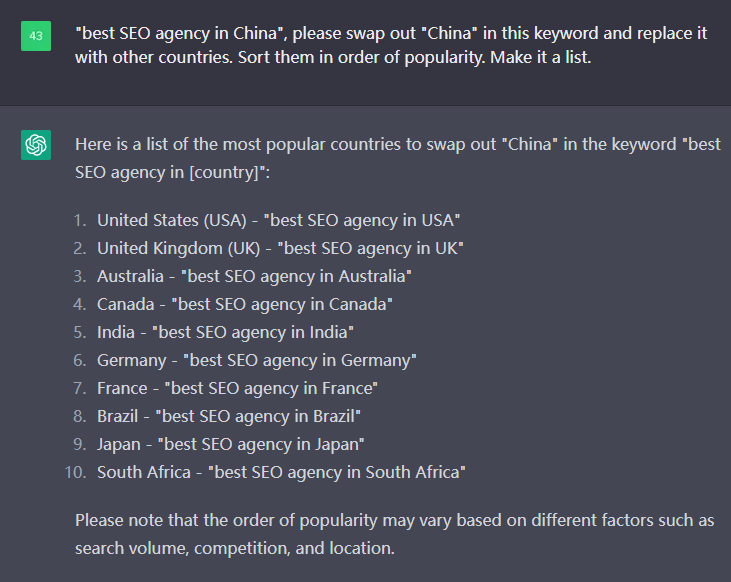
而在这个例子中,我让ChatGPT将“enterprise seo”中的“enterprise”更换成其他同一组,生成了一组意义相近的关键词列表。
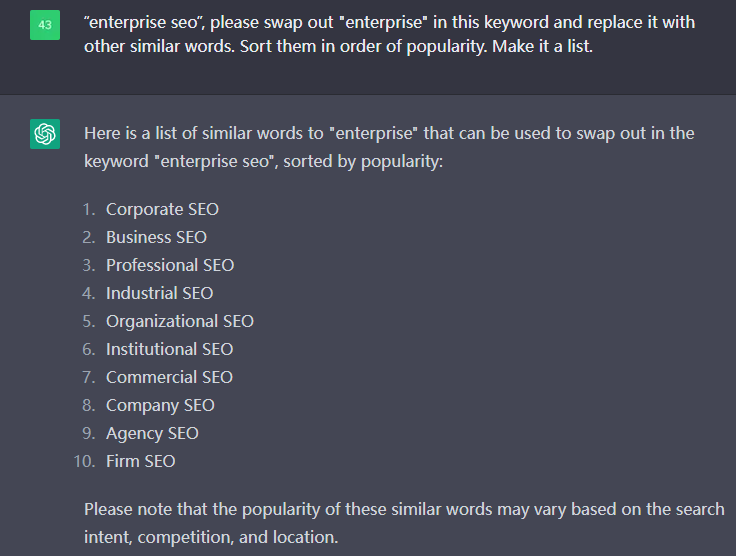
在下面这个例子中,ChatGPT不但更换了我让它更换的词,它还“主动”将句子中的其他词更换成同义词:
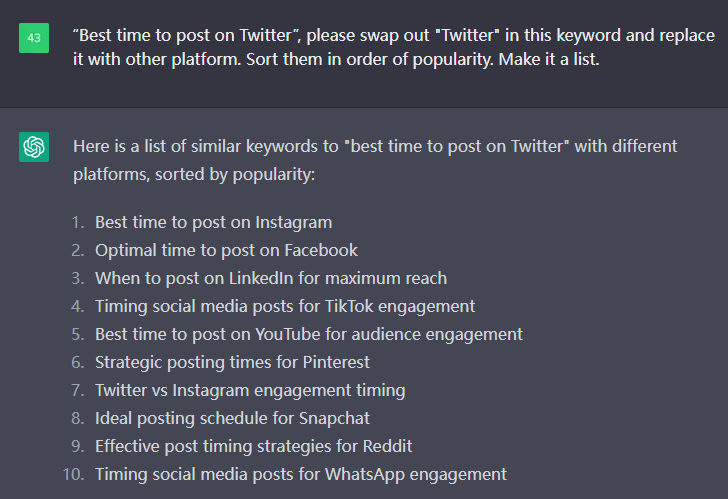
3. 查找长尾关键词
您还可以用 ChatGPT 查找关于某个主题的长尾查询。
您的查询指令可以是:Find X Long-tail keywords for “Keyword”(中文: 为“关键词”找到X个长尾关键词)
在下面这个例子中,我觉得ChatGPT的长尾关键词找得不是很好,列表所给出的答案似乎更适用于标题。
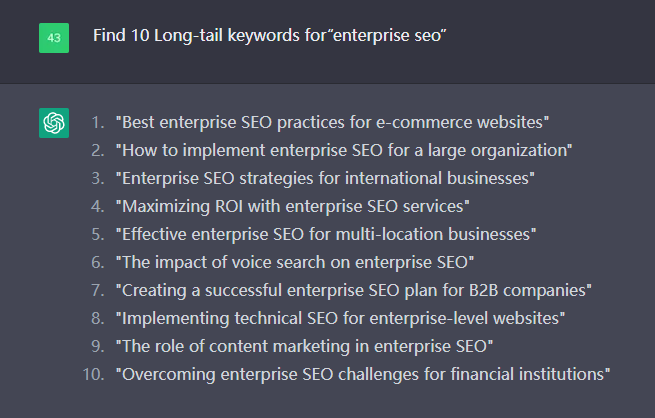
我在同一个对话中换了两个关键词让它继续帮忙生成长尾关键词,结果仍旧没有太大变化:
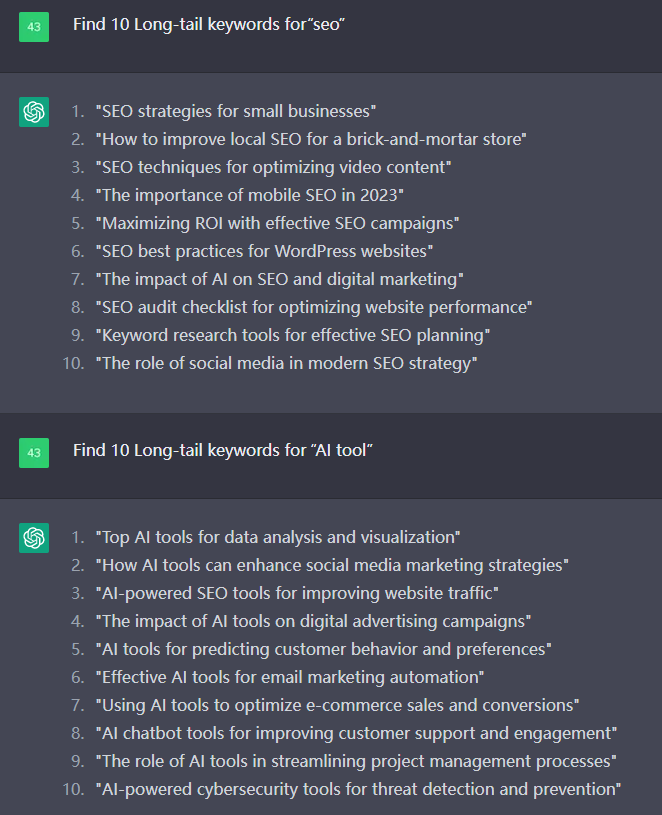
我接着换了一个新的对话,似乎正常了一些:
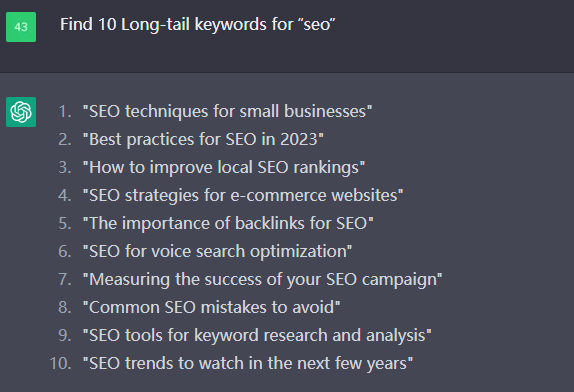
ChatGPT会根据前后对话进行作答。在必要时,大家开启新的对话让答案不受到之前提问的影响。
如果这也不是您想要的长尾关键词列表,您可以尝试换个问法:
示例2:Make a list of long-tail keywords based on the primary keyword ‘keyword’
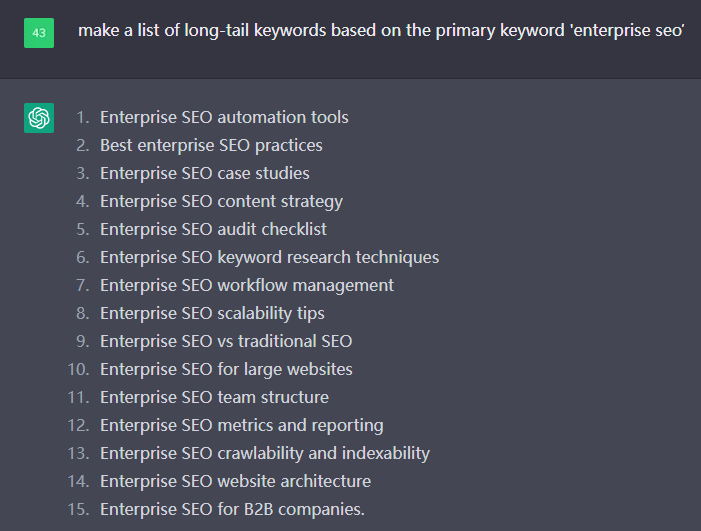
4. 查找LSI关键词
在前些年,SEO领域对语义相关关键词(LSI)的讨论很多,市面上也出现了一些LSI关键词工具。实际上,ChatGPT也可以帮您找出许多与“种子关键词”语义相关的关键词。
您的查询指令可以是:List X LSI keywords for “Keyword” (中文:请列出X个与“关键词”语义相关的词。
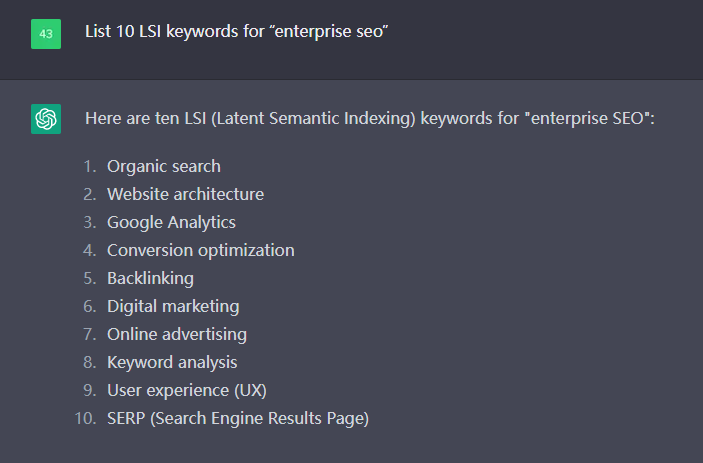
5. 聚类语义相关的关键词
您还可以用ChatGPT将语义相关的关键词进行分类。
您的查询指令可以是:Cluster list of keywords based on their semantic relevance. (中文: 请对语义相关的关键词进行分类)
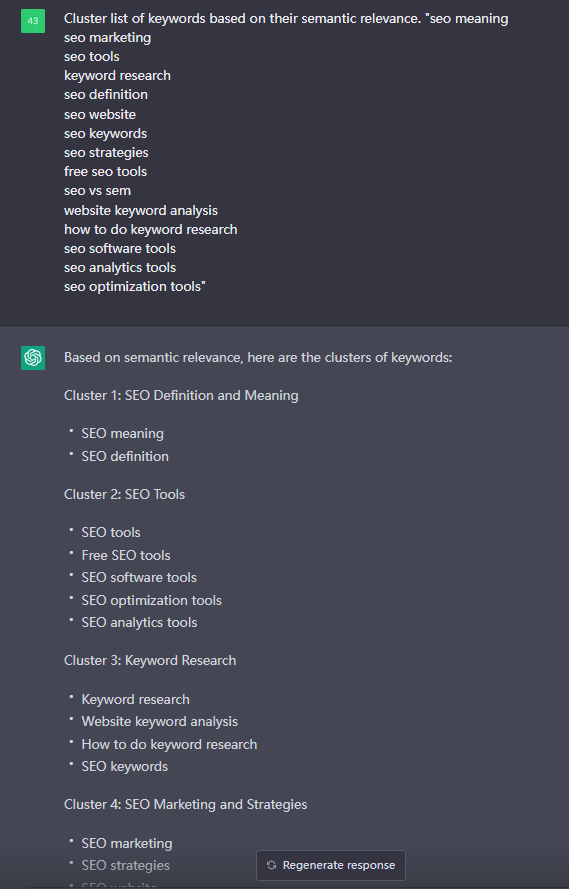
6. 根据搜索意图对关键词进行分类
有一长串关键字?
不用担心!
ChatGPT 可以帮助您根据搜索意图对关键字进行排序并简化您的流程。
您的提问指令可以是:Classify the following keywords based on search intent in a table with the first column for keyword and the second for search intent <list of keywords> (中文:请根据下列关键词的搜索意图将它们分成两列,第一列展示关键词,第二列展示搜索意图)
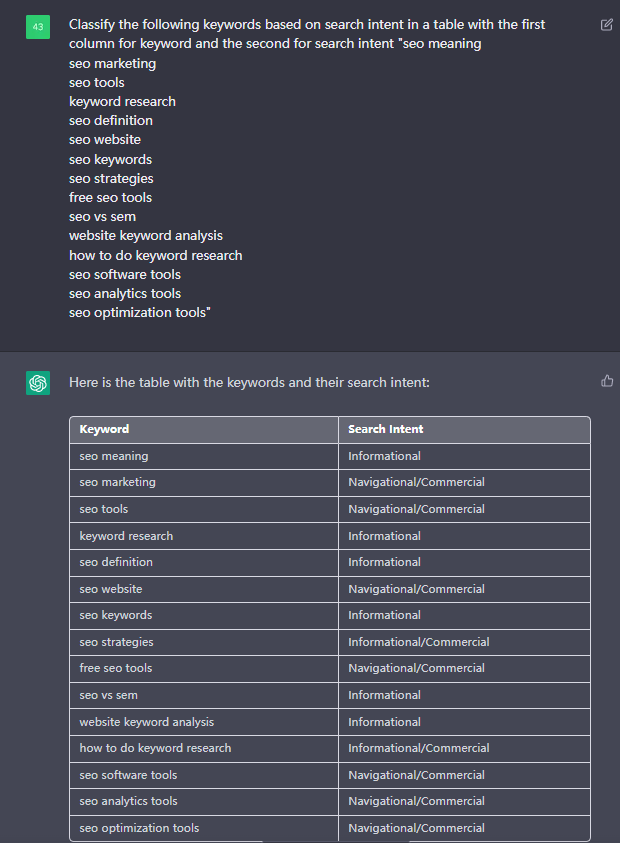
7. 列出与关键词相关的问题
利用ChatGPT广泛的知识库的力量来查找用户提出的常见问题。这些“提问型”关键词可以用于丰富我们的文章内容,通常用在FAQ页面或者文章结尾。
您的提问指令可以是:Generate a list of questions on “Keyword”(中文: 请生成与“关键词”相关的常问问题列表)
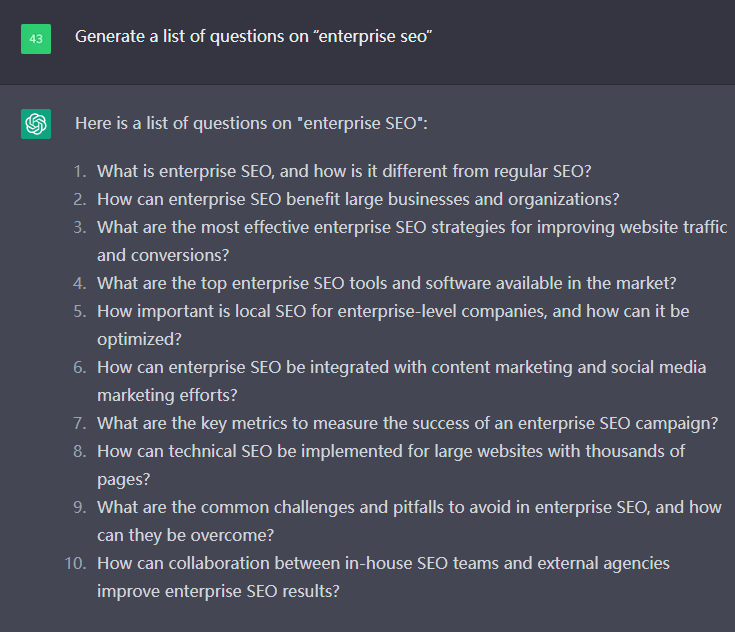
8. 从内容中提取关键词
类似Ahrefs的工具允许您通过输入竞争对手的URL来获得竞争对手获得排名的关键词列表。
ChatGPT也允许您从竞争对手的内容提取相关关键字。
您的提问指令可以是:Find keyword ideas from the following text “Content”(中文: 从以下文本“内容”中提取相关关键字)
我的提问:
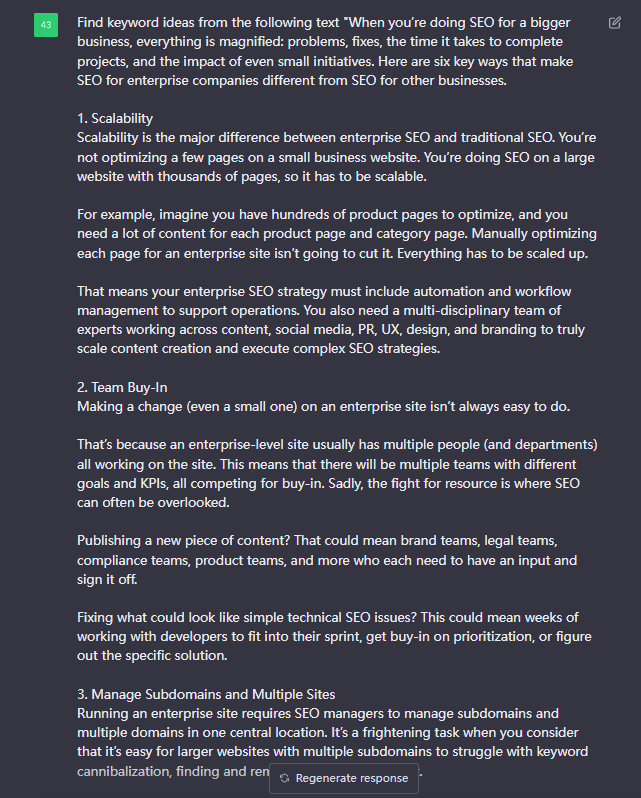
ChatGPT的回答:
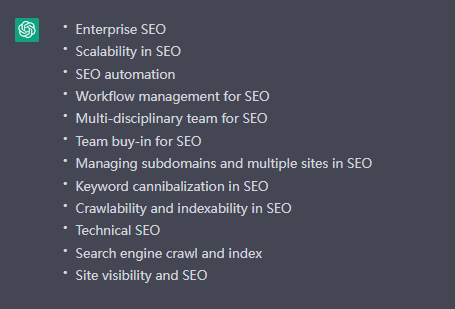
9. 生成一个完整的关键词策略
最后,您还可以通过输入详细的提示让ChatGPT帮您生成一个关键词策略。
这是我的提问指令:
Pretend like you are a market research specialist having accurate and detailed information about available keywords. You are also capable of developing a full SEO content plan.
Create a table with a list of keywords for content SEO plan for <TOPIC>.
Categorize the keywords according to top categories, and enter the name of super category in the first column named ‘Keyword Cluster’. Next, add second column named ‘Long-Tail Keyword’ containing a long-tail keyword for each super-category. Add third column ‘Search Intent’ for the human search intent of the keyword (commercial, transactional or informational). Add fourth column ‘Title’ suggesting that a catchy and SEO-friendly title for the post about the keyword. In the last column ‘Meta Description’ write a compelling meta description optimized for high CTR for the topic, with a maximum length of 155 characters. The meta description should mention why the content is helpful to the reader in a very concise manner, do not make it generalized. I want the response in table format only, do not return anything else. The table should contain the following columns: Keyword Cluster, Long-Tail Keyword, Search Intent, Title, and Meta Description.
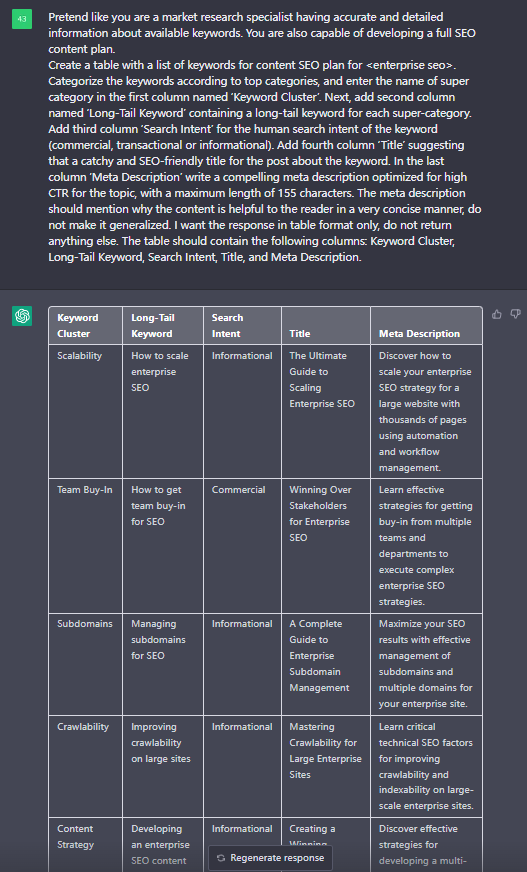
从ChatGPT的答案中,我们可以看到,这种关键词策略非常适合用于规划SEO主题集群的内容。
总结 —— 使用 ChatGPT进行关键词研究
总体上,目前用ChatGPT用于关键词研究还没有使用其他关键词工具(例如Ahrefs)方便与高效。但ChatGPT也有明显的优点,例如它可以根据搜索意图对关键词进行分类。最厉害的是,它可以生成一份完整的关键词策略 —— 这是我在任何SEO关键词工具中都没有看到过的。

